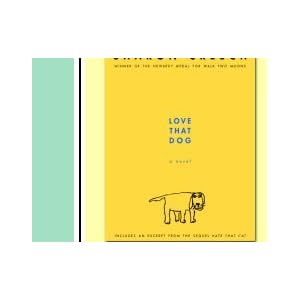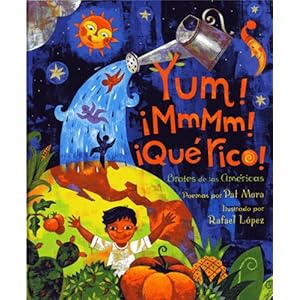
Bibliography –
Creech, Sharon. 2001. Love that dog: A novel. New York: HarperCollins Publishers. ISBN – 9780060292874.
Critical Review –
Creech creates a verse novel that is powerfully funny yet powerfully poignant. The story is of an adolescent boy named Jack who initially believes that writing poetry is just for girls. Creech masterfully lays out the plot through the journal writings of Jack. His journal covers from September 3th to June 6th which represents a school year. Jack writes in his journal as part of class assignments in response to poems that his teacher Miss Stretchberry reads to the class. The poems that are referred to are included at the end for reference. While the teacher does not make a direct appearance, the reader learns quite a bit about her. She does not give up on Jack and continually encourages him in his poetry writing and his desire to write a letter to the poet Walter Dean Meyers asking him to visit their school.
Each poem is generally short but packed with meaning. She uses a variety of devices to convey meaning. She uses italics to show dialogue that Jack is repeating from his teacher. Another interesting use of type is when she changes the font to match a word like typing the word small in a very small font or the word thin in a very tall thin font. One of the most endearing qualities is the use of authentic comedy conveyed through the voice of Jack. It would be difficult if not impossible to read Jack’s critique of Robert Frost’s poem “The Pasture” and not laugh out loud. Jack’s voice is childlike but makes powerful points. For example, Jack uses the phrase, “get killed dead.” While it may seem repetitious from an adult point of view, his meaning is crystal clear. The finality of death echoes through his young voice.
At first, Jack begins experimenting with poetry as words written in short lines and demands that his poems remain anonymous. Eventually he is confident enough to share with his classmates that he is the poet. Throughout the journal, the reader witnesses Jack grow as a poet all culminating in his heart wrenching poem about his dog Sky. It is probably a good idea to have a box of tissue handy for this one. Even though it is superbly foreshadowed, the reader feels compelled to read each word.
Below is one poem that Jack is very reluctant to share because it is one that he states was inspired by the poet Walter Dean Meyers, and he is afraid that Mr. Meyers may get upset with him for copying his words.
Love That Dog
(Inspired by Walter Dean Myers)
By Jack
Love that dog,
like a bird loves to fly
I said I love that dog
like a bird loves to fly
Love to call him in the morning
love to call him
"Hey there, Sky!"
Kid Connection –
To introduce the poem, read the first stanza of the poem “Love That Boy” by Walter Dean Meyers. Then, have to students read “Love That Dog” by Jack reading alternating lines. As a follow-up, explain that Jack was afraid that Mr. Meyers may be upset about Jack copying so much of his poem. Read some of the poems from the novel that reveal this fear. Next, have the students discuss whether or not they feel Mr. Meyers would get upset.





